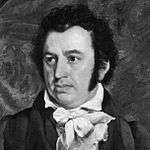Samuel Wells Williams
| Samuel Wells Williams | |
|---|---|
.jpg) S. Wells Williams | |
| Born |
September 22, 1812 Utica, New York, USA |
| Died | February 16, 1884 (aged 71) |
| Occupation | linguist, missionary and Sinologist |
Samuel Wells Williams (衛三畏; 22 September 1812 - 16 February 1884) was a linguist, official, missionary and Sinologist from the United States in the early 19th century.
Early life
Williams was born in Utica, New York, son of publisher William Williams and wife Sophia, an elder of the First Presbyterian Church. At age 8 he was impressed by the departure to Ceylon as a printing missionary of a James Garrett who was associated with his father's printing business. He studied at Rensselaer Polytechnic Institute in Troy, New York. There he assisted in the writing of a botanical manual by Senior Professor and co-founder Amos Eaton, published 1833.[1]:504–5 On graduation he was elected as a professor of the institute.
China
After a year's preparation, on 15 June 1833, just 21, he sailed for China to take charge of the printing press of the American Board of Commissioners for Foreign Missions at Guangdong, China. He arrived at Whampoa, Canton, aboard the Morrison on 25 October 1833.[1]:505 With the death of the pioneering missionary Robert Morrison the next year, he and Elijah Bridgman, who had arrived only three years ahead of Williams, were the only missionaries in the whole of China. He assisted Bridgman in the latter's Chinese Chrestomathy in the Canton Dialect, published in 1842,[2] and Walter Medhurst in completing his English-Chinese Dictionary of 1848, two early works of Chinese lexicography.[1]:506
In 1837 he sailed on the Morrison to Japan. Officially this trip was to return some stranded Japanese sailors, but it was also an unsuccessful attempt to open Japan to American trade.
On November 20, 1845 Williams married Sarah Walworth. From 1848 to 1851 Williams was the editor of The Chinese Repository, a leading Western journal published in China. In 1853 he was attached to Commodore Matthew Calbraith Perry's expedition to Japan as an official interpreter.
In 1855, Williams was appointed Secretary of the United States Legation to China. During his stay in China, he wrote A Tonic Dictionary Of The Chinese Language In The Canton Dialect (英華分韻撮要) in 1856. After years of opposition from the Chinese government, Williams was instrumental in the negotiation of the Treaty of Tientsin, which provided for the toleration of both Chinese and foreign Christians.
In 1860, he was appointed chargé d'affaires for the United States in Beijing. He resigned his position on October 25, 1876, 43 years to the day that he first landed at Guangzhou in 1833. Around 1875, he completed a translation of the Book of Genesis and the Gospel of Matthew into Japanese, but the manuscripts were lost in a fire before they could be published.
He returned to the United States in 1877 and became the first Professor of Chinese language and literature in the United States at Yale University. Williams was nominated as president of the American Bible Society on February 3, 1881. He died on February 16, 1884.
Works
- Elijah Coleman Bridgman, Samuel Wells Williams, ed. (1832–51). The Chinese Repository. Canton: Printed for the proprietors. Retrieved 3 July 2016.
- "Narrative of a Voyage of the ship Morrison, Captain David Ingersoll, to Lewchew and Japan, in July and August, 1837". The Calcutta Christian Observer, vol. 7: 37. 1838. Retrieved 2 July 2016.
- Samuel Wells Williams (1842). Easy lessons in Chinese: or progressive exercises to facilitate the study of that language. MACAO: Chinese Repository.
- Samuel Wells Williams (1844). English & Chinese vocabulary in the court dialect. Macao: Office of the Chinese Repository. p. 440.
- Williams, Samuel Wells (1848). The Middle Kingdom: a survey of the geography, government, education, social life, arts, religion, etc. of the Chinese Empire and its inhabitants. New York: Wiley and Putnam. Retrieved 8 May 2011.
- Account of a Japanese romance (1849)
- S Wells Williams (1856). Ying Wá Fan Wan Tsüt Lú: A Tonic Dictionary of the Chinese Language in the Canton Dialect. Canton: The Chinese Repository. p. 792.
- The Chinese commercial guide (1856)
- Samuel Wells Williams (1874). A syllabic dictionary of the Chinese language: arranged according to the Wu-fang Yuen Yin, with the pronunciation of the characters as heard in Peking, Canton, Amoy, and Shanghai. Shanghai: American Presbyterian Mission Press. p. 1254. Retrieved 2011-07-06.
- Chinese Immigration (1879)
- Samuel Wells Williams (1910). F W Williams, ed. A journal of the Perry expedition to Japan (1853-1854). Retrieved 11 January 2016.
Publications
References
- 1 2 3 Lane, G; Sanford, P P (1834). Methodist Quarterly Review. Methodist Church.
- ↑ Bridgman, Elijah Coleman (10 June 1841). Chinese Chrestomathy in the Canton Dialect. p. Preface.
- "God's China: The Middle Kingdom of Samuel Wells Williams," Ch 6 in John Rogers Haddad. The Romance of China : Excursions to China in U.S. Culture, 1776-1876. (New York: Columbia University Press, 2008). ISBN 9780231130943 (cloth alk. paper) ISBN 9780231504041 (e-book).
- Frederick Wells Williams, The Life and Letters of Samuel Wells Williams, Ll.D., Missionary, Diplomatist, Sinologue (New York: G.P. Putnam's sons, 1889). vi, 490p. at Internet Archive (link).
- James Muhlenberg Bailey, "Obituary Samuel Wells Williams," Journal of the American Geographical Society of New York 16 (1884): 186-93.
- Biography of Samuel Wells Williams in The Far East, New Series, Volume 1, December 1876, pages 140-2.
- Biography with photo
